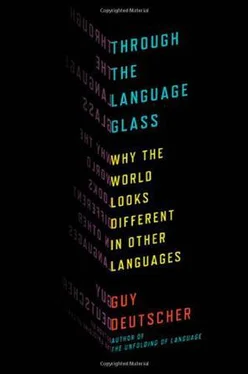It was difficult not to get carried away by the view. Sapir and Whorf became convinced that the profound differences between languages must have consequences that go far beyond mere grammatical organization and must be related to profound divergence in modes of thought. And so in this heady atmosphere of discovery, a daring idea about the power of language shot to prominence: the claim that our mother tongue determines the way we think and perceive the world. The idea itself was not new-it had been lying around in a raw state for more than a century-but it was distilled in the 1930s into a powerful concoction that then intoxicated a whole generation. Sapir branded this idea the principle of “linguistic relativity,” equating it with nothing less than Einstein’s world-shaking theory. The observer’s perceptions of the world-so ran Sapir’s emendation of Einstein-depend not only on his inertial frame of reference but also on his mother tongue.
The following pages tell the story of linguistic relativity-a history of an idea in disgrace. For as loftily as it had once soared, so precipitously did the theory then crash, when it transpired that Sapir and especially his student Whorf had attributed far-fetched cognitive consequences to what were in fact mere differences in grammatical organization. Today, any mention of linguistic relativity will make most linguists shift uneasily in their chairs, and “Whorfianism” has largely become an intellectual tax haven for mystical philosophers, fantasists, and postmodern charlatans.
Why then should one bother telling the story of a disgraced idea? The reason is not (just) to be smug with hindsight and show how even very clever people can sometimes be silly. Although there is undeniable pleasure in such an exercise, the real reason for exposing the sins of the past is this: although Whorf’s wild claims were largely bogus, I will try to convince you later that the notion that language can influence thoughts should not be dismissed out of hand. But if I am to make a plausible case that some aspects of the underlying idea are worth salvaging and that language may after all function as a lens through which we perceive the world, then this salvaging mission must steer clear of previous errors. It is only by understanding where linguistic relativity went astray that we can turn a different way.
WILHELM VON HUMBOLDT
The idea of linguistic relativity did not emerge in the twentieth century entirely out of the blue. In fact, what happened at Yale-the overreaction of those dazzled by a breathtaking linguistic landscape-was a close rerun of an episode from the early 1800s, during the high noon of German Romanticism.
The prevailing prejudice toward the study of non-European languages that Edward Sapir gently mocked in 1924 was nothing to poke fun at a century earlier. It was simply accepted wisdom-not just for the “ordinary man of intelligence” but also among philologists themselves-that the only languages worthy of serious study were Latin and Greek. The Semitic languages Hebrew and Aramaic were occasionally thrown into the bargain because of their theological significance, and Sanskrit was grudgingly gaining acceptance into the club of classical worthies, but only because it was so similar to Greek and Latin. But even the modern languages of Europe were still widely viewed as merely degenerate forms of the classical languages. Needless to say, the languages of illiterate tribes, without great works of literature or any other redeeming features, were seen as devoid of any interest, primitive jargons just as worthless as the primitive peoples who spoke them.
It was not that scholars at the time were unconcerned about the question of what is common to all languages. In fact, from the seventeenth century onward, the writing of learned treatises on “universal grammar” was very much in vogue. But the universe of these universal grammars was rather limited. Around 1720, for instance, John Henley published in London a series of grammars called The Compleat Linguist; or, An Universal Grammar of All the Considerable Tongues in Being . All the considerable tongues in being amounted to nine: Latin, Greek, Italian, Spanish, French, Hebrew, Chaldee (Aramaic), Syriac (a later dialect of Aramaic), and Arabic. This exclusive universe offered a somewhat distorted perspective, for-as we know today-the variations among European languages pale in significance compared with the otherness of more exotic tongues. Just imagine what misleading ideas one would get on “universal religion” or on “universal food” if one limited one’s universe to the stretch between the Mediterranean and the North Sea. One would travel in the different European countries and be impressed by the great divergences between them: the architecture of the churches is entirely different, the bread and cheese do not taste at all the same. But if one never ventured to places farther afield, where there were no churches, cheese, or bread, one would never realize that these intra-European differences are ultimately minor variations in essentially the same religion and the same culinary culture.
In the second half of the eighteenth century, the view was beginning to widen slightly, as various attempts were made to compile “universal dictionaries”-lists of equivalent words in languages from different continents. But although the scope and ambition of these catalogs gradually grew, they didn’t go much beyond a linguistic cabinet of curiosities showcasing weird and wonderful words. In particular, the dictionaries revealed little of value about the grammar of exotic languages. Indeed, for most philologists at the time, the notion that the grammar of a barbarian language could be a worthwhile subject of study seemed perverse. Studying grammar meant the study of Greek and Latin, because “grammar” was the grammar of Greek and Latin. So when remote languages were described (not by philologists but by missionaries who needed them for practical purposes), the descriptions usually consisted of a list of Latin paradigms on one side and the allegedly corresponding forms in the native language on the other side. The nouns in an American Indian language, for example, would be shown in six forms, corresponding to the six cases of the Latin noun. Whether or not the language in question made any case distinctions was irrelevant-the noun would still be duly frogmarched into nominative, genitive, dative, accusative, vocative, and ablative. The French writer Simon-Philibert de La Salle de l’Étang demonstrates this frame of mind in his 1763 dictionary of Galibi, a now extinct language of the Caribbean, when he complains that “the Galibis have nothing in their language that makes distinctions of case, for which there should be six in the declension of each word.” Such descriptions seem to us today like clumsy parodies, but they were conceived in complete earnestness. The notion that the grammar of an American Indian language might be organized on fundamentally different principles from those of Latin was simply beyond the intellectual horizon of the writers. The problem was much deeper than the failure to understand a particular feature of the grammar of a particular New World language. It was that many of the missionaries didn’t even understand that there was something there to understand.
Enter Wilhelm von Humboldt (1767-1835), linguist, philosopher, diplomat, educational reformer, founder of the University of Berlin, and one of the stellar figures of the early nineteenth century. His education-the best of what the Berlin Enlightenment scene had to offer-imbued him with unbounded admiration for classical culture and for the classical languages. And until he reached the age of thirty-three, there was little to show that he would one day break out of the mold or that his linguistic interests would ever extend beyond the revered Latin and Greek. His first publication, at the age of nineteen, was about Socrates and Plato; he then wrote about Homer and translated Aeschylus and Pindar. A happy lifetime of classical scholarship seemed to stretch in front of him.
Читать дальше











